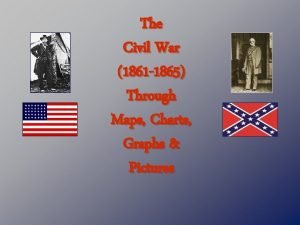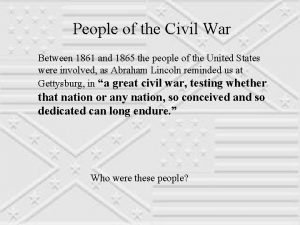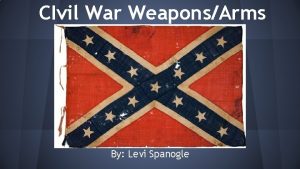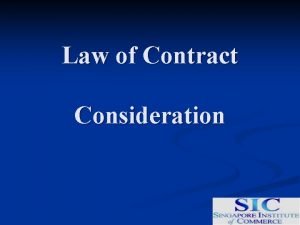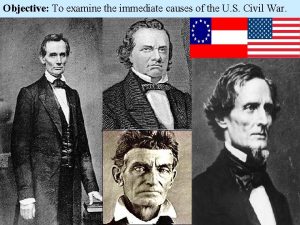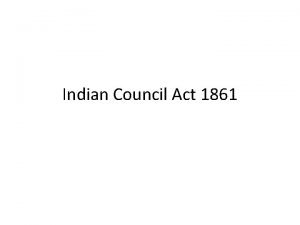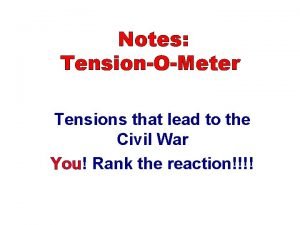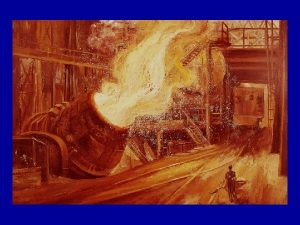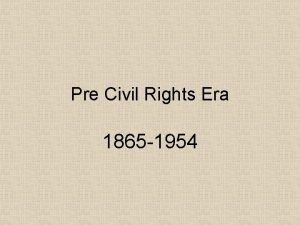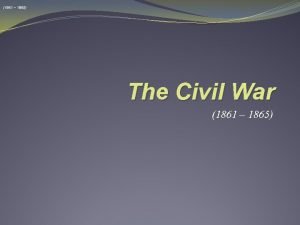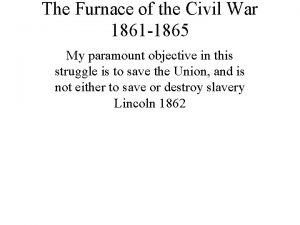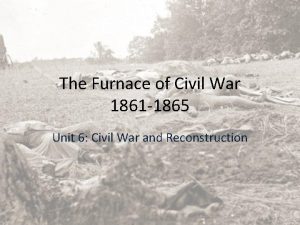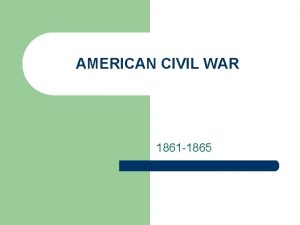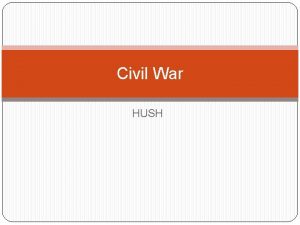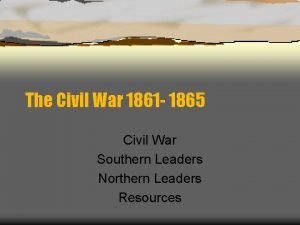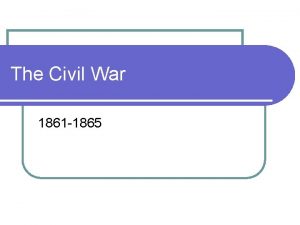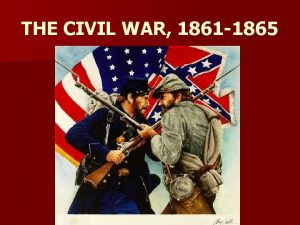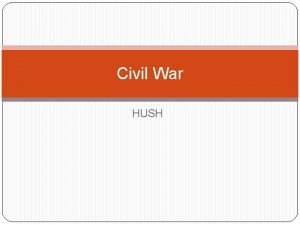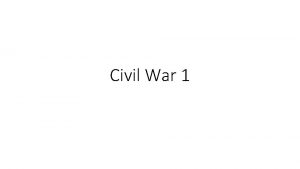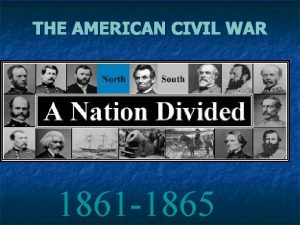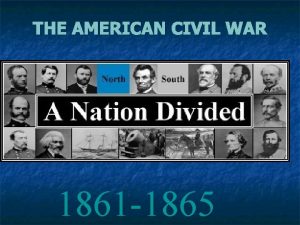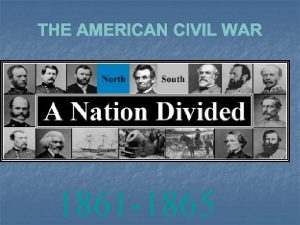The Furnace of the Civil War 1861 1865






















- Slides: 22

The Furnace of the Civil War 1861 -1865 PAGEANT CHAPTER 21

Things You Need To Know North = United States, Union, Federal – blue uniforms South = Confederate States, Confederacy, Rebels – gray uniforms

The United States - 1861

The United States - 1861

1 a. Strategy and Early Battles July 1861 – The Battle of Bull Run; the first major military engagement between the Union and the Confederacy – Manassas, Virginia Lincoln and the Union expected a quick war…they were horribly wrong The Union Army marched preemptively victorious out of Washington and “On to Richmond!”; as it was their goal to take the Confederate capital Civilians showed up to the battlefield as spectators When both forces met; the Union had a strong start, but the Confederates stood their ground under General Thomas “Stonewall” Jackson ordered the Confederate troops to wait for the Union to get close, fire, then charge with their bayonets (knives on the end of their rifles) The Union Army was soon in disorder and retreat Confederates win the first major battle Union – march defeated back to Washington but not finished…

General Thomas Jackson (CSA)

1 a. Strategy and Early Battles The problem for the South was that the Battle of Bull Run, though a victory, diminished any chance for re-admittance to the Union on easy terms; the Confederacy had crossed a line into a point of no return… The Peninsula Campaign – 36 year old general George Mc. Clellan took over the Union Army. Mc. Clellan was young, cocky, flashy, and brilliant at training troops, but his talents did not translate in the field, as he was often too hesitant when it came to moving his troops forward into battle Mc. Clellan was also unprepared for the brilliant Robert E. Lee, commander of Confederate forces in Virginia, who, unlike Mc. Clellan, took risks Due to Mc. Clellan’s slow movements and devastating losses inflicted by the Confederates under Lee, the Union fails to take Richmond Lincoln changes the Union strategy from bringing the South back with minimal conflict to total war The Confederacy will still brought back into the Union, but there has to be punishment

General George Mc. Clellan (USA)

General Robert E. Lee (CSA)

1 a. Strategy and Early Battles Six elements of the Union Strategy 1) Blockade the Southern coasts 2) Free the slaves thereby ruining their economy 3) Take the Miss. River to cut the South in half 4) Send troops into GA & the Carolinas 5) Take the capital of Richmond 6) Use the Union’s superior numbers to grind down the smaller Southern forces

Union Strategy

2. a. , b. Antietam and Emancipation The embargo devastated the South though they did try to fight it The most serious threat to the Union blockade was the Confederate ironclad ship, the Merrimack, which would eventually be challenged by a Union iron-clad ship, the Monitor in 1862 Meanwhile, General Lee, emboldened by his brilliant successes against the Union, made daring move to invade the Union. A victory on Union soil could lead Lincoln to negotiate with the Confederacy September 1862, Lee and Mc. Clellan’s forces meet again at Antietam Creek, Maryland. Militarily the battle was a draw, and the bloodiest single day battle – 26, 000 casualties in all – both failed in their attempts to achieve what they wanted

Monitor vs. the Merrimack

2. b. , c. Antietam and Emancipation Some historians consider Antietam the most decisive battle in the war. 1) Britain and France were on the verge of helping the Confederacy but pulled back after the Union showed strength at Antietam 2) It provided Lincoln the support to issue the Emancipation Proclamation When Lincoln took the presidency before the war in 1861, he had no intentions of interfering with slavery By 1863, everything would change with the Emancipation Proclamation 1) Lincoln’s aim was to cause rebellion in the South 2) It made the Civil War a moral war for freedom against the ways of slavery and the Old South After the issuance of the Proclamation, any hopes the Confederacy had of enlisting the help of Britain and France were dashed It should also be remembered that the border states were allowed to keep their slaves – further showing the Emancipation to be a political maneuver

2. d. Antietam and Emancipation As a result of the Proclamation, slaves began leaving the deep South in droves and coming to the North Many enlisted in the Union Army Some 180, 000 joined up and eventually made up 10 percent of total enlistments of Union ground forces

3. The War at Midpoint After Antietam, Lincoln continued to chase Lee’s army around Northern Virginia using a series of generals. Mc. Clellan ends up fired and so do several more The Confederacy was declining but not out of fight Chancellorsville, VA – Lee’s “perfect battle” Lee and Stonewall Jackson score a devastating victory at Chancellorsville but it comes at a cost – Jackson is killed by friendly fire July 1863 – Union and Confederate forces meet again in the small town of Gettysburg in Pennsylvania – the northern most battle of the war Union forces under General George Meade dig in, with good position on a hill in the town Lee, with overconfidence, tries a risky charge across a massive field but fails colossally, losing 1/3 of his men Lee withdraws and though he fights on for another two years, is never again a serious threat

3. The War at Midpoint Meanwhile, in the west, Ulysses S. Grant and his Union forces are trying to take the Mississippi River This would be accomplished by the Union victory at Vicksburg, the day after the Gettysburg victory Grant would be promoted to the Union commander The remainder of the Union strategy in the west would be under William Tecumseh Sherman, who would march a massive force through Georgia, burning Atlanta, and then the Carolinas, putting the nail in the coffin of the Southern war effort

4. Politics of the War Despite what you may think, the North wasn’t united against the war effort Many opposed and Lincoln stood chance of losing re-election Copperheads – people who lived in the North but either supported the Confederacy or didn’t want to fight the war However, key Union victories at Gettysburg and Vicksburg would help Lincoln win re-election in 1864 against troublesome general George Mc. Clellan.

Battle Location Map

4. War’s End and Lincoln’s Death Grant’s success got him promoted to commander of the Union forces Grant’s orders? Defeat the elusive General Lee and take Richmond Grant’s strategy? None really – just take a larger force into Virginia and continue to send troops into battle against Lee’s dwindling forces Lee was forced to surrender at Appomattox Court House in April 1865 Triumph and joy overtake the Union, but it is not completely sweet Abraham Lincoln is assassinated while attending a play 2 weeks after the war’s end at Ford’s Theatre in Washington He is killed by John Wilkes Booth, a Confederate sympathizer Booth escapes and is on the run 12 days before being cornered and killed by U. S. troops in Virginia Four other conspirators are hanged in the aftermath of the assassination Lincoln’s death tragically marred what should have been the greatest celebration of the American Republic since the Revolution Worse yet, was that with Lincoln, went any chance that the period of transition after the war would go smoothly

Lee’s Surrender

Lincoln Assassinated
 Civil war 1861/1862
Civil war 1861/1862 Civil war 1861/1862
Civil war 1861/1862 The furnace of civil war
The furnace of civil war The furnace of civil war
The furnace of civil war Why was the civil war considered the first modern war
Why was the civil war considered the first modern war Toward civil war lesson 3 secession and war
Toward civil war lesson 3 secession and war Unionistička stranka 1861
Unionistička stranka 1861 Springfield model 1861 rifle facts
Springfield model 1861 rifle facts Currie v misa
Currie v misa John brown poster
John brown poster Features of indian council act 1861
Features of indian council act 1861 Tensionometer
Tensionometer Civil rights webquest
Civil rights webquest The rise of industrial america 1865-1900
The rise of industrial america 1865-1900 Hollywood silver fox farm v emmett
Hollywood silver fox farm v emmett Regionalism in american literature
Regionalism in american literature Becoming a world power 1865-1917
Becoming a world power 1865-1917 Al cruzar una planta de guisantes de flores purpura
Al cruzar una planta de guisantes de flores purpura Four features of industrial manufacturing (1865-1900)
Four features of industrial manufacturing (1865-1900) Industrialization (1865 to 1901 worksheet answers key)
Industrialization (1865 to 1901 worksheet answers key) What are characteristics of impressionism
What are characteristics of impressionism Where did the term impressionism come from
Where did the term impressionism come from 15 th ammendment
15 th ammendment
